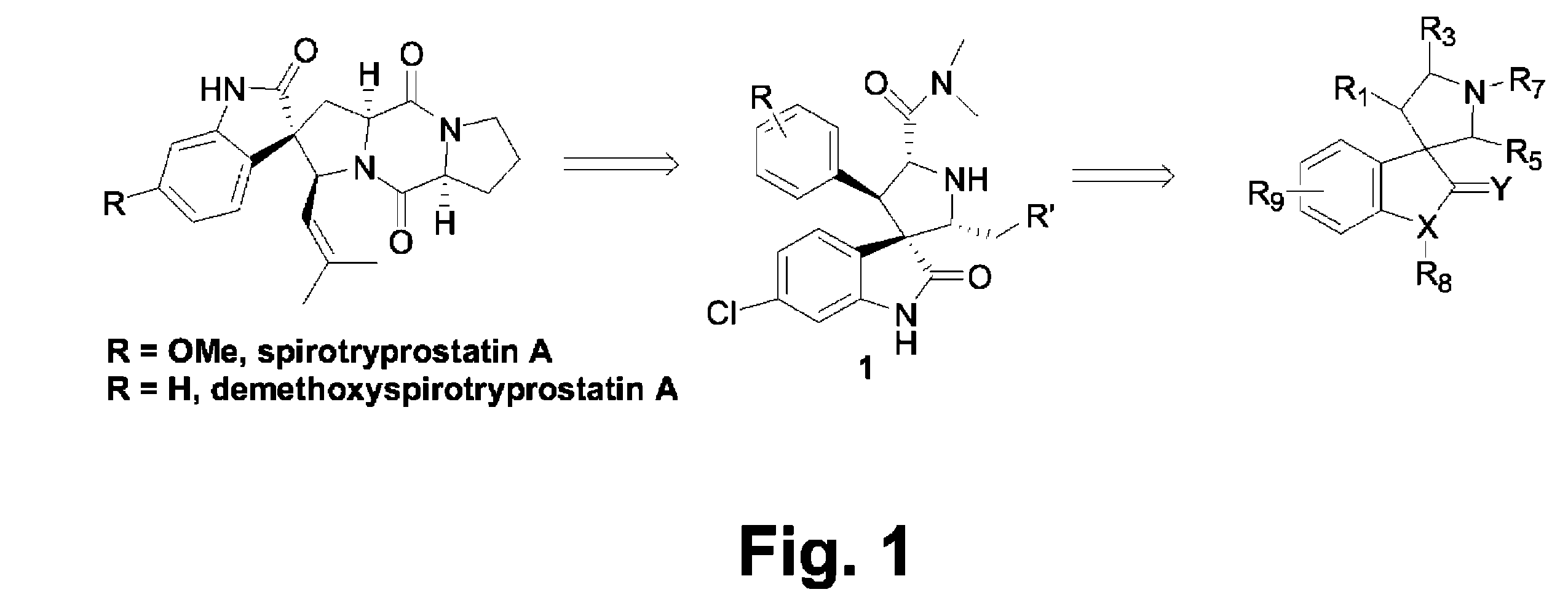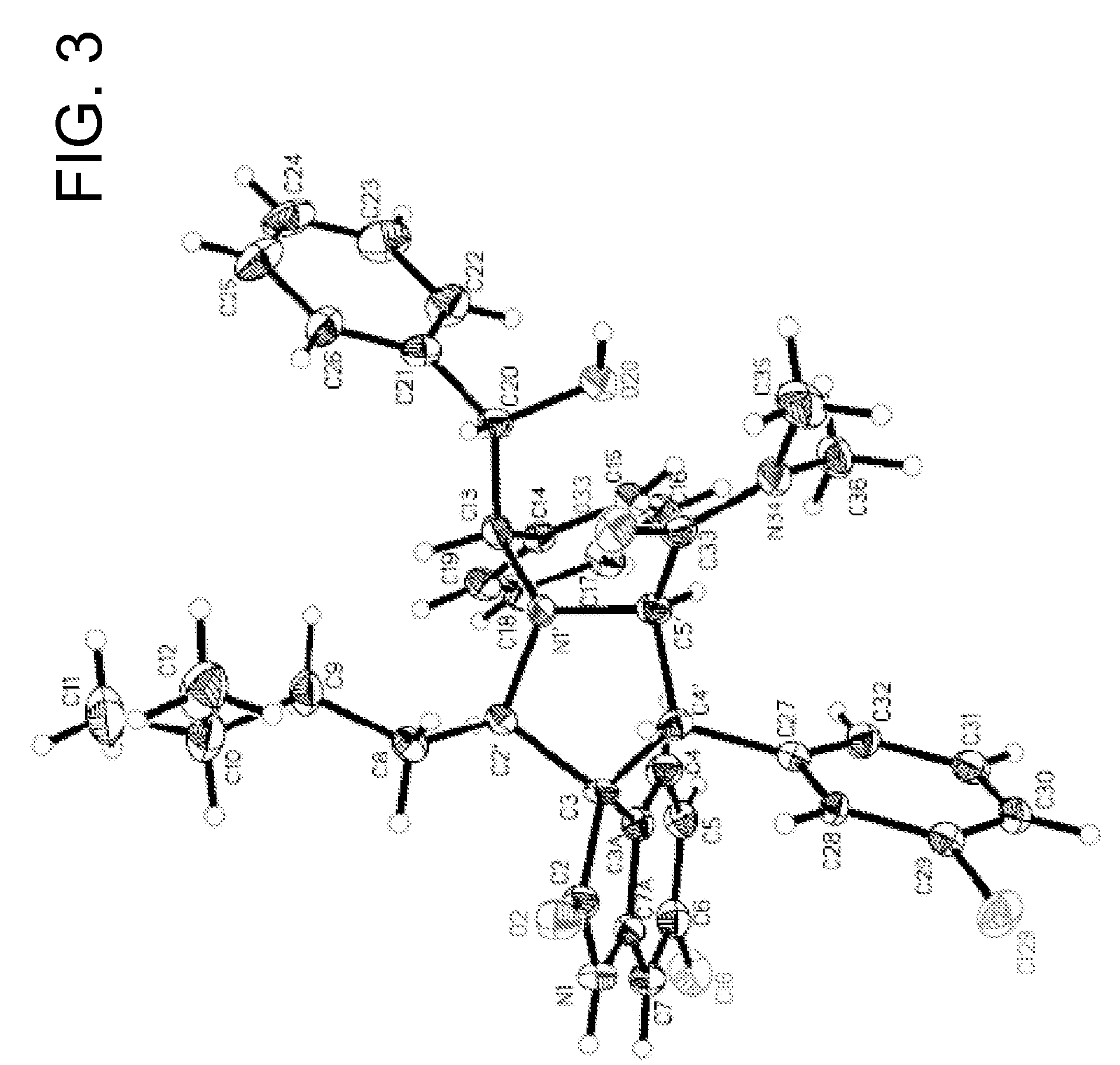Small molecule inhibitors of MDM2 and the uses thereof
a small molecule inhibitor and inhibitor technology, applied in the field of medicinal chemistry, can solve the problems of limited success of high throughput screening strategies in identifying potent, non-peptide small molecule inhibitors, and achieve the effects of less toxic, less toxic, and greater tumor response and clinical benefi
- Summary
- Abstract
- Description
- Claims
- Application Information
AI Technical Summary
Benefits of technology
Problems solved by technology
Method used
Image
Examples
example 1
Design of MDM2 Inhibitors
Since many anti-cancer drugs are either natural products or contain a core pharmacophore derived from natural products, a search was done for natural products that could provide a novel scaffold for the design of compounds capable of inhibiting the interaction between p53 and MDM2.
Computational docking studies were carried out using the GOLD program (version 2.1) with the ChemScore fitness function. The structures of ligands were constructed at SYBYL 6.9 and energy minimized by Tripos force field. The MDM2 structure was extracted from the crystal structure of MDM2 bound with p53 (PDB code: 1YCR). Hydrogens were added to the protein using SYBYL 6.9. The active site was defined to encompass all atoms within a 12 Å radius sphere, whose origin was located at the center of the Trp23 of the p53 peptide. The standard Genetic Algorithm protocol was selected for the docking. For each compound, 20 individual docking runs were conducted. The generated 20 solutions of e...
example 2
Fluorescence Polarization Binding Assay
Compound 1a was synthesized as shown in Scheme 1 using an asymmetric 1,3-dipolar reaction as the key step (Sebehar et al., J. Am. Chem. Soc. 122:5666 (2000)). The absolute stereochemistry of 1a and other designed analogues was determined by an X-ray crystallographic analysis of one of the key intermediates, (1″R,2″S,2′R,3′R,3S,4′R)6-chloro-4′-(3-chloro-phenyl)-1′-(2-hydroxy-1,2-diphenyl-ethyl)-2′-(3-methyl-butyl)-2-oxo-1,2-dihydro-spiro[indole-3,3′-pyrrolidine]-5′-carboxylic acid dimethylamide (FIG. 3).
To determine the ability of 1a to disrupt the interaction between MDM2 and p53, a fluorescence polarization (FP)-based binding assay was established using a recombinant human MDM2 protein and a p53-based peptide (Garcia-Echeverria et al., J Med Chem 43:3205 (2000)) labeled with a fluorescence tag. The fluorescent-probe, termed PMDM6-F, had the sequence (5-Fam-βAla-βAla-Phe-Met-Aib-pTyr-(6-Cl-1-Trp)-Glu-Ac3c-Leu-Asn-NH2) (SEQ ID NO:1), wherein Fam...
example 3
One major advantage of non-peptide small-molecule inhibitors over peptide-based inhibitors is their superior cell permeability. It is predicted that potent, non-peptide inhibitors of the p53-MDM2 interaction such as 1d will be effective in inhibition of cell growth and division in cancer cells with a wild-type form of p53 through stimulation of the activity of p53. Furthermore, they are predicted to have selectivity in cancer cells with either a loss of p53 or a mutated, non-functional form of p53. To test these predictions, a cell growth assay was developed using human prostate cancer LNCaP (p53 wild-type) and PC-3 (p53 null) cell lines. The toxic effects of compounds on normal cells were also examined on a normal prostate epithelial cell line.
Cells were seeded in 96-well flat bottom cell culture plates at a density of 3-4×103 cells / well and incubated in the presence of compounds for 4 days. The rate of cell growth inhibition after treatment with increasing co...
PUM
| Property | Measurement | Unit |
|---|---|---|
| resistance | aaaaa | aaaaa |
| cell permeability | aaaaa | aaaaa |
| crystal structure | aaaaa | aaaaa |
Abstract
Description
Claims
Application Information
 Login to View More
Login to View More - R&D
- Intellectual Property
- Life Sciences
- Materials
- Tech Scout
- Unparalleled Data Quality
- Higher Quality Content
- 60% Fewer Hallucinations
Browse by: Latest US Patents, China's latest patents, Technical Efficacy Thesaurus, Application Domain, Technology Topic, Popular Technical Reports.
© 2025 PatSnap. All rights reserved.Legal|Privacy policy|Modern Slavery Act Transparency Statement|Sitemap|About US| Contact US: help@patsnap.com



